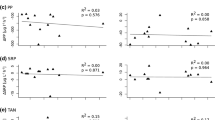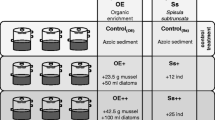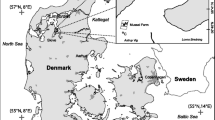Abstract
Nitrogen pools and transformations and benthic communities at a Perna canaliculus farm and a nearby reference site without direct influence of marine farming in Kenepuru Sound, New Zealand, were compared on four dates between September 1982 and May 1983. The organic nitrogen pool in the top 12 cm sediment was 7.4 to 10.8 mol m-2 at the mussel farm and 6.1 to 8.9 mol m-2 at the reference site. The nitrate and nitrite pools were similar in both sediments, but the ammonium pool in the mussel farm sediment was about twice as high as in the reference sediment. In January, the sediment ammonium concentrations ranged from 418 nmol cm-3 (surface) to 149 nmol cm-3 (12 cm depth) at the mussel farm and from 86 to 112 nmol cm-3 at the reference site. The molar C:N ratio of the sediment organic matter was 6.2 to 7.2 at the mussel farm and 7.9 to 10.0 at the reference site. The molar N:P ratio of the sediment organic matter was 4.3 to 7.2 and 3.3 to 6.1 at mussel farm and reference site, respectively. The total nitrogen mineralisation rate in the top 12 cm sediment ranged from 21.7 to 37.1 mmol m-2 d-1 at the mussel farm and from 8.5 to 25.0 mmol m-2 d-1 at the reference site. Ammonium excretion by mussels was about 4.7% (January) and 7.4% (May) of the combined nitrogen mineralisation by mussels and sediment. The sediment-denitrification rate was 0.7 to 6.1 mmol m-2 d-1 at the mussel farm and 0.1 to 0.9 mmol m-2 d-1 at the reference site. In January, 76 and 93% of the nitrate reduced in the sediments were denitrified at the mussel farm and reference site, respectively. The denitrification rate on the mussel lines (determined on detritus-covered mussels) was twice the mussel farm sediment-denitrification rate and 10 times the reference sediment-denitrification rate. Total denitrification at the mussel farm was 21% higher than at the reference site. The loss of nitrogen through mussel harvest and denitrification was 68% higher at the mussel farm. The surface layers of both sediments contained about 75 mg m-2 chlorophyll a. Sediment phaeophytin levels were 52 mg m-2 at the reference site and 137 mg m-2 at the mussel farm. While the benthic infauna of the mussel-farm sediment consisted only of polychaete worms, the reference sediment contained also bivalve molluscs, brittle stars and crustaceans.
Similar content being viewed by others

Literature cited
American Public Health Association: Standard methods for the examination of water and wastewater, 15th ed. pp 415, 420–421. Washington, D.C.: American Water Works Association and Water Pollution Control Federation 1980a
American Public Health Association: Standard methods for the examination of water and wastewater, 15th ed. pp 429–432. Washington, D.C.: American Water Works Association and Water Pollution Control Federation 1980b
American Public Health Association: Standard methods for the examination of water and wastewater, 15th ed. pp 152–155. Washington, D.C.: American Water Works Association and Water Pollution Control Federation 1980c
Blackburn, T. H.: Method for measuring rates of NH +4 turnover in anoxic marine sediments, using a 15N−NH +4 dilution technique. Appl. envirl Microbiol. 37, 760–765 (1979)
Blackburn, T. H. and K. Henriksen: Nitrogen cycling in different types of sediments from Danish waters. Limnol. Oceanogr. 28, 477–493 (1983)
Bremner, J. M.: Total nitrogen. In: Methods of soil analysis, Part 2. pp 1149–1178. Ed. by C. A. Black. Madison: American Society of Agronomy 1965
Carter, L.: Seston transport and deposition in Pelorus Sound, South Island, New Zealand. N.Z. Jl mar. Freshwat. Res. 10, 263–282 (1976)
Dahlbäck, B. and L. Å. H. Gunnarsson: Sedimentation and sulfate reduction under a mussel culture. Mar. Biol. 63, 269–275 (1981)
Day, P. R.: Particle size fractionation and particle size analysis. In: Methods of soil analysis, Part 1. pp 552–562. Ed. by C. A. Black. Madison: American Society of Agronomy 1965
Heath, R. A.: Temporal variability in the waters of Pelorus Sound, South Island, New Zealand. N.Z. Jl mar. Freshwat. Res. 16, 95–110 (1982)
Henriksen, A.: Determination of total nitrogen, phosphorus and iron in fresh water by photo-oxidation with ultraviolet radiation. Analyst 95, 601–608 (1970)
Hunter, B. L. and E. A. Laws: ATP and chlorophyll a as estimators of phytoplankton carbon biomass. Limnol. Oceanogr. 26, 944–956 (1981)
Jenkins, R. J.: Mussel cultivation in the Marlborough Sounds (New Zealand), 75 pp. Wellington: New Zealand Fishing Industry Board 1979
Kaspar, H. F.: Denitrification in marine sediment: measurement of capacity and estimate of in situ rate. Appl. envirl Microbiol. 43, 522–527 (1982)
Kaspar, H. F. and J. M. Tiedje: Response of electron-capture detector to hydrogen, oxygen, nitrogen, carbon dioxide, nitric oxide and nitrous oxide. J. Chromat. 193, 142–147 (1980)
Knowles, R.: Common intermediates of nitrification and denitrification and the metabolism of nitrous oxide. In: Microbiology 1978, pp 367–371. Ed. by D. Schlessinger. Washington D.C.: American Society for Microbiology 1978
Lorenzen, C. J.: Determination of chlorophyll and phaeo-pigments: spectrophotometric equations. Limnol. Oceanogr. 12, 343–346 (1967)
Meredyth-Young, J. L.: World beating technology in Sounds. Catch (N.Z. Minist. Agric. Fish.) 10, 17–18 (1983)
Redfield, A. C., B. Ketchum and F. Richards: The influence of organisms on the composition of seawater. In: The sea, Vol. 2. pp 26–77. Ed. by M. Hill. New York: Interscience 1963
Rosenfeld, J. K.: Ammonium adsorption in nearshore anoxic sediments. Limnol. Oceanogr. 24, 356–364 (1979)
Ryther, J. H.: The potential of the estuary for shellfish production. Proc. natn. Shellfish. Ass. 59, 18–22 (1969)
Ryther, J. H. and W. M. Dunstan: Nitrogen, phosphorus, and eutrophication in the coastal marine environment. Science, N.Y. 171, 1008–1013 (1971)
Solórzano, L.: Determination of ammonia in natural waters by the phenol-hypochlorite method. Limnol. Oceanogr. 14, 799–801 (1969)
Steele, J. H.: Environmental control of photosynthesis in the sea. Limnol. Oceanogr. 7, 137–150 (1962)
Strickland, J. D. H. and T. R. Parsons: A manual of sea water analysis. Bull. Fish. Res. Bd Can. 125, 153–163 (1960)
Strickland, J. D. H. and T. R. Parsons: Determination of reactive nitrate. Bull. Fish. Res. Bd Can. 167, 71–76 (1968)
Tenore, K. R., L. F. Boyer, R. M. Cal, J. Corral, C. Garcia-Fernandez, N. Gonzalez, E. Gonzalez-Gurriaran, R. B. Hanson, J. Iglesias, M. Krom, E. Lopez-Jamar, J. McClain, M. M. Pamatmat, A. Perez, D. C. Rhoads, G. de Santiago, J. Tietjen, J. Westrich and H. L. Windom: Coastal upwelling in the Rías Bajas, NW Spain: contrasting the benthic regimes of the Rías de Arosa and de Muros. J. mar. Res. 40, 701–772 (1982)
Tiedje, J. M., A. J. Sexstone, D. D. Myrold and J. A. Robinson: Denitrification: ecological niches, competition and survival. Antonie van Leeuwenhoek 48, 569–583 (1982)
Yoshinari, T. and R. Knowles: Acetylene inhibition of nitrous oxide reduction by denitrifying bacteria. Biochem. biophys. Res. Commun. 69, 705–710 (1976)
Author information
Authors and Affiliations
Additional information
Communicated by G. F. Humphrey, Sydney
Rights and permissions
About this article
Cite this article
Kaspar, H.F., Gillespie, P.A., Boyer, I.C. et al. Effects of mussel aquaculture on the nitrogen cycle and benthic communities in Kenepuru Sound, Marlborough Sounds, New Zealand. Mar. Biol. 85, 127–136 (1985). https://doi.org/10.1007/BF00397431
Accepted:
Issue Date:
DOI: https://doi.org/10.1007/BF00397431



